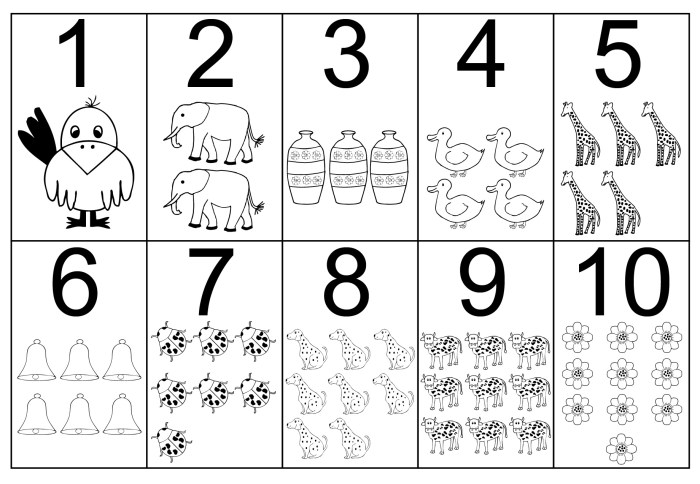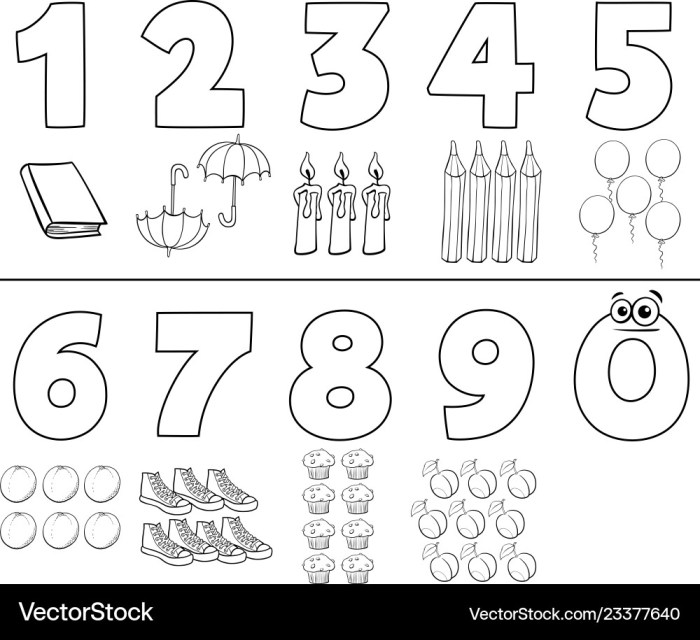Content Creation & Complexity

Coloring book with numbers – Creating a number coloring book involves careful consideration of the target audience’s age and skill level. The complexity of the number sequences and illustrations should be appropriately matched to ensure engagement and avoid frustration. Educational elements can be seamlessly integrated to enhance the learning experience. A variety of illustrative styles can also be employed to cater to different aesthetic preferences.
The design process involves a thoughtful approach to difficulty levels, educational integration, and artistic style. This ensures a captivating and enriching experience for the user. Successful number coloring books strike a balance between challenge and reward, making the activity both engaging and educational.
Difficulty Levels in Number Coloring Books
Different difficulty levels can be achieved through variations in the number sequences and illustration complexity. Here are three examples:
Below are examples demonstrating varying levels of complexity, from simple to advanced. These examples focus on the visual and numerical challenges presented to the user.
The quiet joy of numbered hues, a meditative dance of color within the lines, finds a vibrant counterpart in the thrilling world of superhero adventures. For those seeking a different kind of challenge, consider the dynamic action of coloring book pages spiderman , a leap from numbered precision to expressive freedom. Then, return to the soothing rhythm of numbers, a gentle contrast to the web-slinger’s energetic world.
- Easy: The page features large, clearly delineated shapes (e.g., simple geometric shapes like circles, squares, and triangles). Numbers 1-10 are used, each corresponding to a single, large shape. The number sequence is simple and sequential (1, 2, 3, etc.). The illustration could be a simple scene with these shapes forming a basic picture, such as a house made of squares and circles.
- Medium: The page includes more complex shapes (e.g., animals, flowers) composed of multiple smaller shapes. Numbers 1-20 are used, and the sequence may not be strictly sequential (e.g., 1, 3, 5, 2, 4, 6…). The shapes are smaller and require more precise coloring. The illustration might be a more detailed scene with multiple elements, such as a garden with various flowers and insects.
- Hard: The page presents intricate designs incorporating many small shapes and details. Numbers 1-30 or higher are used, with a complex, non-sequential sequence (e.g., a pattern involving prime numbers or Fibonacci sequence). The shapes are very small and require fine motor skills and attention to detail. The illustration could be a complex mandala or a detailed landscape scene.
Educational Elements in Number Coloring Books, Coloring book with numbers
Incorporating educational elements transforms a coloring book into a valuable learning tool.
The inclusion of educational aspects enhances the activity beyond simple coloring, transforming it into a fun and engaging learning experience.
- Number Recognition: Each number could be associated with a specific color, reinforcing number recognition. For example, “Color all the number 1s blue, all the number 2s red, etc.” This simple association helps children solidify their number recognition skills.
- Simple Math Problems: Simple addition or subtraction problems could be included, with the answer corresponding to a specific color. For example, “Color all the shapes where 2 + 2 = 4 green.” This introduces basic mathematical concepts in a fun and interactive way.
- Counting Activities: Sections could be designated for counting objects within the illustration, linking coloring to counting skills. For instance, “Count the number of flowers and color that many petals on the largest flower.” This encourages both counting and observation skills.
Illustrative Styles in Number Coloring Books
Different illustrative styles can enhance the appeal of the coloring book.
The choice of artistic style significantly impacts the overall aesthetic and appeal of the coloring book. Consideration should be given to the target audience and desired mood.
- Realistic: This style depicts objects and scenes in a lifelike manner, emphasizing detail and accuracy. A realistic number coloring book might feature detailed animal portraits or landscapes.
- Cartoonish: This style uses simplified shapes, exaggerated features, and bright colors to create a playful and fun atmosphere. A cartoonish number coloring book might feature whimsical characters or scenes from a children’s story.
- Abstract: This style uses shapes, colors, and patterns without representing recognizable objects. An abstract number coloring book might feature geometric patterns or flowing designs. The focus is on the visual appeal of the colors and forms.
Creating a Color Key or Legend
A color key provides clarity and organization.
A well-designed color key is essential for ensuring a clear understanding of the color assignments, especially in more complex designs.
A simple color key could be a small box at the bottom of the page showing each number and its corresponding color. For example: 1 = Red, 2 = Blue, 3 = Green, and so on. For more complex pages, a more detailed legend with color swatches might be beneficial. The key should be clearly labeled and easy to understand for the target audience.
Production & Distribution: Coloring Book With Numbers

Producing and distributing a number coloring book involves a multi-stage process, from initial design to reaching the end consumer. Careful planning and execution at each stage are crucial for success. This section details the production process, compares printing methods, Artikels distribution channels, and emphasizes the importance of effective packaging.
Production Process of a Number Coloring Book
The creation of a number coloring book begins with the design phase. This involves creating the illustrations, incorporating numbers, and ensuring the overall aesthetic appeal is engaging for the target audience. The design is then finalized, often digitally, and prepared for printing. Next, the chosen printing method is employed, followed by quality control checks to ensure accuracy and color consistency.
Finally, the printed pages are bound, typically using saddle-stitch binding for cost-effectiveness, and prepared for packaging.
Comparison of Printing Methods
Several printing methods are suitable for number coloring books, each with advantages and disadvantages. Offset printing offers high-quality results at a lower cost per unit for large print runs. However, the initial setup costs can be substantial. Digital printing, on the other hand, is ideal for smaller print runs or customized versions, offering flexibility and lower setup costs, but potentially higher per-unit costs for larger quantities.
Screen printing provides a unique, textured feel but is less efficient for complex designs and high volumes. The choice depends on the budget, print run size, and desired quality.
Distribution Channels for Number Coloring Books
Effective distribution is key to reaching the target market. Online marketplaces like Amazon, Etsy, and Shopify offer broad reach and convenience. Partnering with bookstores, both independent and chain stores, provides access to a physical customer base. Participating in craft fairs and local markets offers direct engagement with potential buyers and builds brand awareness. Wholesale partnerships with distributors can significantly expand reach but require careful negotiation and management.
Each channel offers unique opportunities and requires a tailored approach.
Importance of Packaging Design
Packaging plays a crucial role in attracting attention and conveying the product’s value. A well-designed package should be visually appealing, clearly communicate the content (a number coloring book), and highlight key features. For example, a vibrant color scheme with a playful design could attract children, while a more sophisticated design might appeal to adults. Effective packaging can also protect the book during shipping and handling.
Consider using sturdy materials and appropriate sizing to prevent damage. A simple yet effective example might be a brightly colored cardstock cover with a clear window showcasing the artwork inside. Another example could be a more robust cardboard box for larger formats, providing additional protection.
Questions Often Asked
What age group is best suited for number coloring books?
Number coloring books can appeal to a wide age range, from children learning number recognition to adults seeking a relaxing and engaging activity. The complexity of the designs can be tailored to different skill levels.
Are there benefits beyond just coloring?
Absolutely! Number coloring books can improve fine motor skills, enhance focus and concentration, and provide a therapeutic outlet for stress relief. They can also subtly introduce or reinforce mathematical concepts.
Where can I find high-quality number coloring book templates?
Many online resources and design platforms offer templates, or you can create your own using digital design software. Consider exploring sites dedicated to printable coloring pages and art resources.
What type of paper is best for number coloring books?
Thicker paper, such as cardstock or watercolor paper, is ideal to prevent bleed-through, especially when using markers or watercolors. The choice depends on the coloring medium you prefer.
